One of my client (self-taught fashion designer) design clothes for this beautiful fashion collection and when she put them on sale, crickets!
Now how does that feel after so much of time investment and money investment to bring these pieces alive?
The biggest mistake she did is just winged it without knowing who she designing for and what they need and just went with what she loved to create. This works with the school projects but in reality, if you wanna make sales, designing clothes is not just enough.
In this tutorial, I’m gonna help you uncover what steps you need to take to design clothes that people love to buy from you.
P.S. Also, make sure you check this Free Masterclass on Fashion design. This is one of my favorite trainings I ever made…
This is more like the groundwork than the design stuff but if you can complete this, you are going to change the way you design clothes next time.
(We got whole new tutorials specifically on designing clothes before and I’m gonna give the links below)
Related Tutorials:
- The 6 Step Process to come up with unique fashion collection themes,
- How to design a clothing line, step-by-step process (free checklist)
- How to research and develop ideas for your next clothing line
Because you are here, reading this, I gonna help you with all of this today, if you stay till the end.
I promise this will be a super helpful one that you can’t miss out if you want to become a fashion designer.
Today we are going to cover:
- The TOOPA of your customer to create a persona
- The 3 aspects that you need to master to become a fashion designer.
- And fun exercises to go along.
There was this misconception in the fashion industry that Fashion designers dictate Fashion. Meaning, designers design clothes as they like and all people buy it and wear it.
But in reality, that’s gonna be a big flop, if designer goes with that they love.
It’s not really about the designer. It all about the person who wears it.
Before even a fashion designer thinks about his/her designs, they spend a lot on understanding what people actually want. And only then they can expect sales or profit.
And this is why this tutorial is all about finding and understanding the customer and uncovering what they actually need and what makes them buy your product.
It all Begins with the Customer

Most people design clothes first and then think about who wears them. Or worst people design clothes and assume these designs are for everyone. These are the main things that lead to failed designs. Aka No one buys your clothing.
Designing clothes is all about customer-centric. As a designer, we should understand that one person who we want to design for.
(not hundred or all, just think of one person who you would love to design).

And from then you should reverse engineer like what might that one person needs in her wardrobe.
Is she stay at home mom and prefer casuals in her wardrobe? or working a lot under the sun and needs some clothes that cover her body?
Now the problem is…
- How do you identify your ONE ideal person?
- How do you know what she needs?
Don’t worry, I’m not leaving you hanging there,
When you complete this step, you will walk away with your ideal person + what she needs in your hand.
Let’s dive in
So step one is to identify your ideal customer
First of all think about every single person you know in your circle.
- Pick one person that you love to design clothes for out of all. Is it your mum? your granny? your cousin daughter? a friend who lives in a country or abroad?
- Maybe you already got customers before, think of ONE person that you felt working with again and again.
- Get on a phone call with them. Research What do they wear, where do they buy, what colours do they love, what do they hate etc…
If you are a student of Fashion collection Lab, check out the module 1 where I give you the exact survey questions that I use each time and get great results. And yes we go deep about the customer in the same module.
Step 2 is to Create a Persona:
Persona is basically a visual representation of your customer.The main elements inside the persona are, Name, photo of the ideal customer, demographics, shopping habits etc…
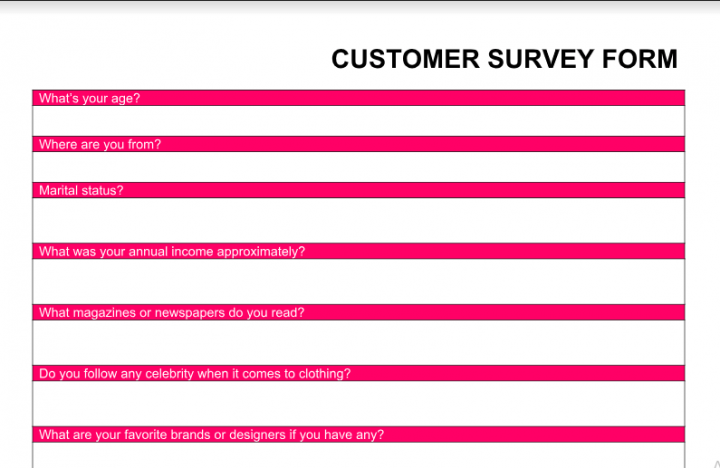
We keep this beside us each time when we design any clothing. It’s like this person is sitting beside us and telling us what she expects from us. So every time we put her in mind and think if this clothing makes sense for this person.
#1 I want you to identify TOOPSA of your customer and create your persona.
TOOPSA is a short form of Time, Occupation, Occasion, Place, Age.
- Time they live: which refers the season like spring, summer, autumn, rainy etc
- Occupation: what do they do for a living (we use this data to designs clothes that she can afford and t understand what type of clothing do she need in her wardrobe)
- Occasion that you want to design for (casual, party, nightwear, loungewear etc…)
- Place they live (oh boy, one of my student designed trench coats for someone who lives in a tropical sweaty climate. Just get to know what her climate looks like and season happening in her place)
- Sex refers gender. male, female,unisex?
- Age of your customer (You may design a skirt differently for a granny compared to 30’s office going women or a kid ) Age tells you what fabrics or colours to use and if it is appropriate for the customer)
#2 Give your customer a name.
#3 Then write a little summary
what she likes and dislikes, based on the phone call.
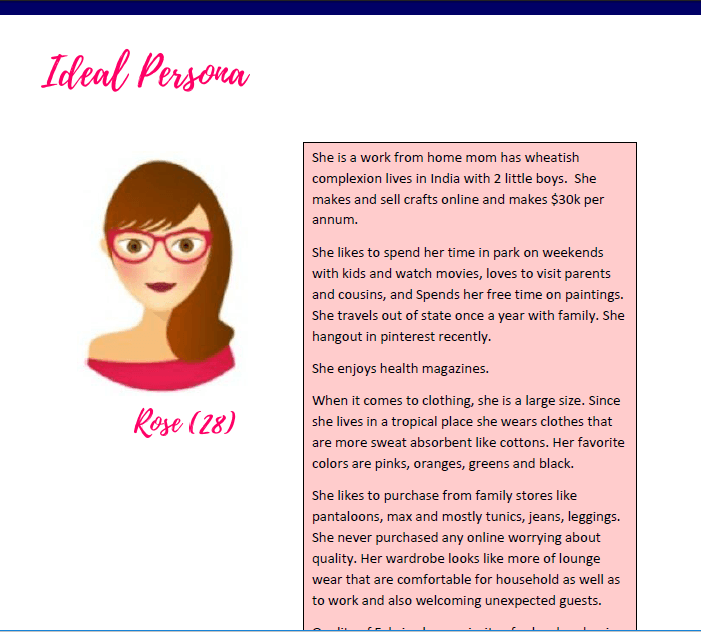
When designing clothes in each step, Put the persona in front of you and I want you to think of this one question. Will this design make sense for my ideal customer? or will my customer like it and wear it?
There you have it.
Here are the action steps for creating your persona:
- Pick a person that suits your ideal client
- Survey them by talking directly to them in a phone call or by person
- Create your persona using a word doc or free software like Canva
Behind the scenes:
One of my first business is I’m more in love with princess ball gowns. But as a beginner, making ball gowns take a lot of investment to materials and labour.
So I need to think small and decided to design ball gowns for kids, so they only take little much of fabric and less time for construction.
Now not every time a kid can wear ball gowns so when exactly will they wear? Probably on parties.
What kind of party? Birthdays.
But again, I can’t afford to design in multiple sizes for every birthday age.
I finally choose to design first birthday gowns.
The next thing, I talked to every new mom around me about
- what do they look when choosing a first birthday gown,
- What type of gowns they don’t like to buy,
- How much can they afford,
- what colours do they prefer and colours they don’t prefer
and questions like that to understand their perspective on shopping and got pretty decent data to work on.
I got some points like:
- It’s hard to find summery kind of gowns so my girl doesn’t irritate for this heat.
- It may not be comfortable to wear that huge gowns for a long time.
- It would be great if I find gowns, not for just one hour party but something she can wear the whole day.
- I want people to remember how amazing that gown was yet comforting for my girl.
What I figured out was all of them are looking for the word “comfortable”
I put all these questions into principles that I can work on like comfort, soft, breathable, lightweight etc…
I finally designed a limited collection Clothing line of first birthday gowns that are summery and mostly using different weights of cotton, rayon fabrics with prints and thread embroideries and that collection was a huge hit of all time.
I used to get calls from people who purchased them to check if I got any new collections later.
I couldn’t have done that if I don’t understand who I design for and what they actually need instead of me thinking that they might need.
3 aspects of designing clothes that you need to master
Now that you know who you design for and what do they need. That’s halfway of designing clothes that people love to buy.
The second part is what makes a design sellable?
For any successful clothing, you need to master 3 aspects of design.
Functional, structural, and decorative
Functional Design
is all about how easy it is to wear or remove your clothing and how it fits or moves along the body.
- Think of a tee shirt that was hard to fit your head while wearing or a
- Button in a shirt always opens up,
- The zipper is hard to move or it was so tight around the chest.
Will you ever wear them?
Definitely not! even if it is a thousand dollar clothing.
Also, is the fabric used is appropriate to the dress? like cotton on summer helps with heat and absorbs any sweat.
The functional design is the main aspect that makes people whether or not to buy your clothes.
Structural Design
refers to the construction quality of how the garment is sewn together.
- Are the finishes good?
- Are seams delicate that they might rip off after wash?
- is sewn good and holds well?
This is all about how the fabric pieces are sewn into a wear and tear structure.
Decorative design,
which is colour or any embellishments that attract people to come closer to your garments.
All these 3 aspects act as pillars in designing clothes and decides the quality of apparel.
Like once a person sees your dress, if they convinced by the decorative design, they get closer to try it and see how it function and easy to wear and comfortable. Then they were gonna see if that structure looks good or is something torn or bothering them.
If one fails, you are not gonna make it.
To learn these aspects even better, I have a little exercise for you to analyze different items of clothing.
Go to a store a pick 3 dresses or tops from 3 different brands.
Try them on and research all the 3 aspects of designs
Functional:
- Is it easy to wear?
- Is it easy to take off?
- does fabric suit the style?
- is it season friendly?
- comfortable to move?
- any discomforts?
Decorative:
- what do you like most in this item that pulled your eye?
- what do you think about the colours and combinations?
- Are the colours season friendly?
- What surface ornamentation was used?
Structural:
- How do the seams look?
- Are all closures sewn well?
- Are there any threads hanging?
- Are there any un-quality stitches?
- How was the hem?
- Is drape good or pulling stitches somewhere?
Compare and give grades for each of the 3 areas.
- Based on all the answers how much do you grade for this item?
- According to you, what can you do to this clothing to make it even better? is there anything that you can eliminate? or add something?
Once you do this exercise, you will able to develop critical skills whenever you go shopping and automatically you start to think of solutions that how can you make it even better.
That brings us to the end of the second part of designing clothes that people love to buy.
Here are the recap and action steps of what we learned today to design clothes that sell.
- You need to identify who you design for?
- Research What do they need?
- Create a persona based on your research.
- Understand the 3 aspects of design that makes people buy your clothing
- Analyze a clothing item of different brands and critique.
- Come up with your own version of that clothing item.
With this information armed up and the action steps to take.
Hopefully, you are going to change the way you design clothes next time with all these things in mind and bring fashions not just what you love but designing clothes that your ideal customer cannot resist buying from you.
Let me know if this is helpful in the comments below and lets chat.
If you need further help make sure you check this Free Masterclass on Fashion design. This is one of my favorite trainings I ever made…

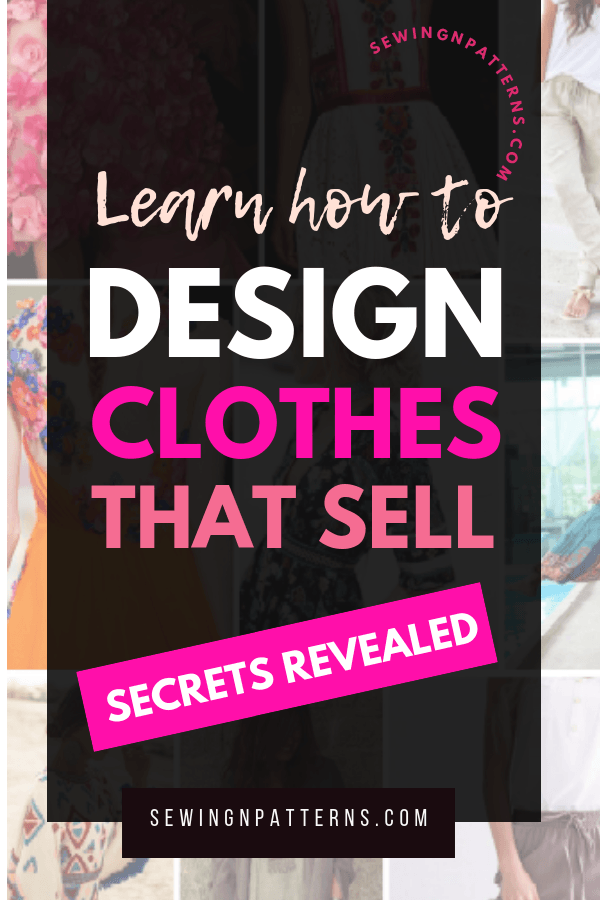
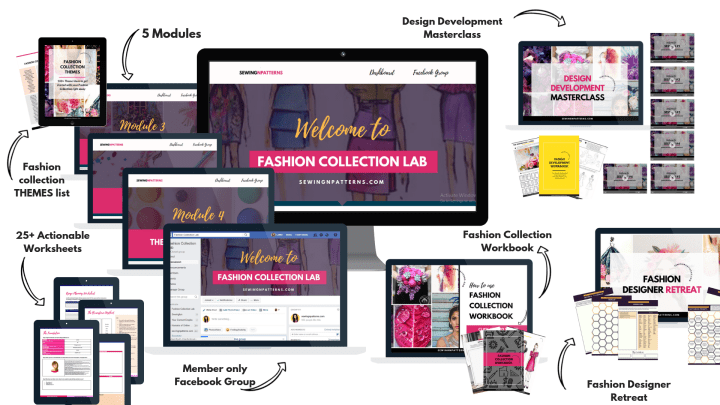
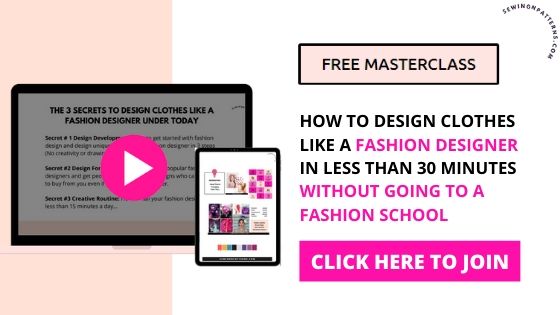
I found this write-up so educational. Each time I read through your lessons, it broaden my knowledge and skills. You are indeed a great fashion tutor. Keep it up Lekha.
It’s so educational, it’s nice read from you.
I like anything that you write . I`ve learned alot from you . Looking forward for your next article . Thank you so much .
Thanks Lekha, you explained this so clearly that i now understand what was my failures in my previous attempts with my designs. Keep up the excellent work you r sharing with us, looking forward to the next article,
This is the best blogpost I’ve read in years.
This piece has been so insightful especially as an evolving designer… I’m highly grateful
Very helpful information. Thanks 😊
do you have a recommendation for a platform to connect with designers to create a clothing item (s)
Thank you
This is so educational and helpful. I gained a lot just reading it. I’m so glad it has so many calls to action. It’s very applicable. Thank you so much for taking out time to do this.
I’m thrilled you enjoyed the post! Your kind words keep the motivation flowing.